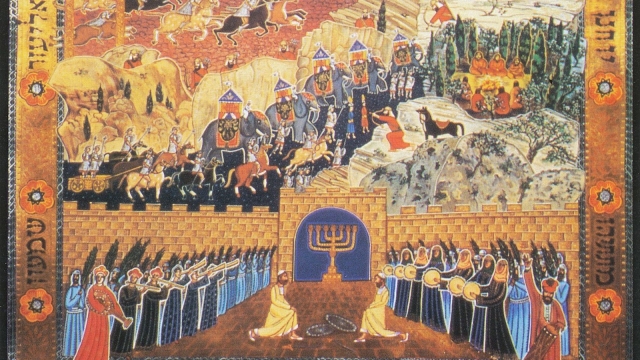After the return of Israelites from the first forced exile by the Babylonian kingdom, there was a lot that was needed in the land of Israel. With approval from the Persian King Cyrus The Great, who had conquered Babylon, three Israelite leaders Malachi, Haggai and Zachariah were put in charge of reconstructing the temple that was destroyed centuries before. During this period, many kings and prophets ruled different parts of the land of Israel, bringing uncertainty to the well-being of the land and unity to the Israelite nation as a whole. The Kings of Israel were never truly meant to be. According to the bible, God did not want a King to rule, however as rabbinical texts explain, the people themselves needed a physical ruler, the concept of an unseen, unheard deity. was beyond their purview. So upon the return to the land, many 'sects' sprouted up with leaders claiming to be the one true king, and it resulted in a fractured Israel. This period of relative turmoil in the land was only exacerbated by the defeat of the Persians by the Hellenists in the year 332 B.C.
With the growing loss of religious freedom for the Jewish people under the Hellenists, a rebellion began in the area that was known as Judea against the foreign rulers. Although outnumbered and ill-equipped, Historians of the time describe a relatively swift victory for the rebels due to out-of-the-ordinary military tactics that were likened to guerilla warfare, and a stronger emotional connection to the land they were fighting on and for. Essentially, they wanted it more and as a result, they were victorious. The revolt was led by a group known throughout history as the ‘Maccabees’. These ‘rebels’ created what can be classified as the first Jewish, Democratic State, an independent kingdom in the land of Judea, that became known as the Hasmonean dynasty.
Growing internal conflict ultimately led to the fall of the Hasmoneans in the year 37 B.C. Many define it is a civil war, some call it political upheaval brought on by the priests who were frustrated they were not on top of the caste system that had existed during the days when Israel was ruled by kings. The Roman imperialists who were positioned to the north in modern-day Syria saw the unrest and seized the opportunity to move in and conquer Judea.
The Roman rule over the land of Israel was relatively short-lived but brought many changes. A Jew-by-birth known as Herod was put in charge of Judea and while seeking the affection of local Jews, he took it upon himself to rebuild much of the war-torn land. One of his greatest and well-known architectural accomplishments was the refurbishing of the second temple. The full-on ‘face-lift’ for the temple itself and the mountain on which it stands brought the golden age of the second temple. Until today, many who vision the third temple being built would like it to meet the standards of Herod’s design.
After the death of 'Herod the Great' in 4 B.C, the land of Israel was divided into 3 portions to be controlled by the different sons of Herod. This division and lack of true unified leadership brought unrest throughout the land and began a period known as the Jewish-Roman wars. A notable world-changing figure that stemmed from this period, Jesus of Nazareth, was a prominent Jew fighting not just the Roman occupation, but the corruption of the priests who had aligned themselves with Rome so they could resume their hierarchal position on top of Israelite culture - mostly for the purpose of enriching themselves. Jesus and his growing legion of followers wanted to purify the temple from what they saw as corrupt priests who had no mandate to tend to the Temple other than their allegiance to Rome. Jesus and his minion's ultimate goal was to bring the land of Israel back together, unifying it under the one true God while eliminating the autocratic nature of the rulers that had come before. Jesus fought to put control of Judea back in the hands of the people and let them rule themselves.
In the year 66 A.C the first official Jewish-Roman war broke out, with many of the reasons stemming from a lack of autonomy and high taxes. Although the first years of this conflict were a complete success for the Jewish rebels, being able to stop forces greater than 6000 men, eventually the Roman empire triumphed. In the year 70 A.C, a Roman general known as Titus, defeated the Rebelion strong-hold of Jerusalem and destroyed the second temple of the Jewish people.
Remaining Jewish forces fought to the bitter end, hiding in the Judean desert, their last stand was on top of a mountain called Masada. The rebels who were fortified and beseiged by the Roman troops, chose to commit suicide instead of surrendering and taking on the life of a slave.
The destruction of the second temple is considered one of the biggest tragedies in Jewish history, and led to the longest period of non-Jewish sovereignty over the land of Israel.
Along with a revolt that continued througout the Roman empire, the final stand of Jewish rebels against Romans in the land of Israel is named after its leader, Bar Kochba. This time, the Roman legions showed little mercy against the Jewish populations, using wildfires induced by troops and the salting of agricultural fields as tactics in suppressing any and all uprisings. The consequences of the final revolt led to the mass deportation of Israelite descendants throughout the Roman diaspora, known as the period of ‘Galut’ ( exile or banishment in Hebrew).
Although a Jewish presence was always recorded in Israel, specifically Jerusalem, the holy land faced thousands of years of being tossed around by different empires and conquerors.


